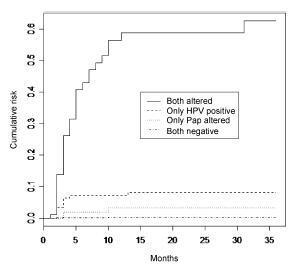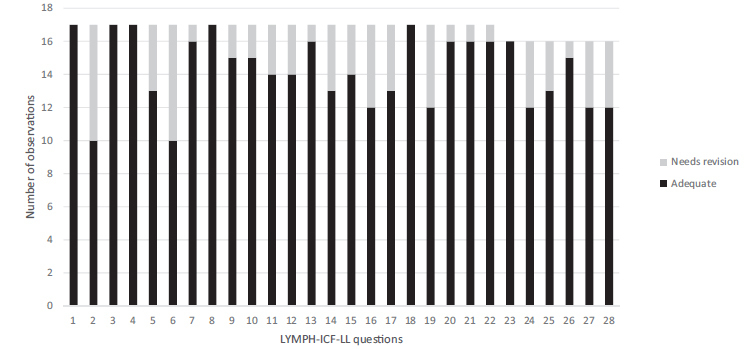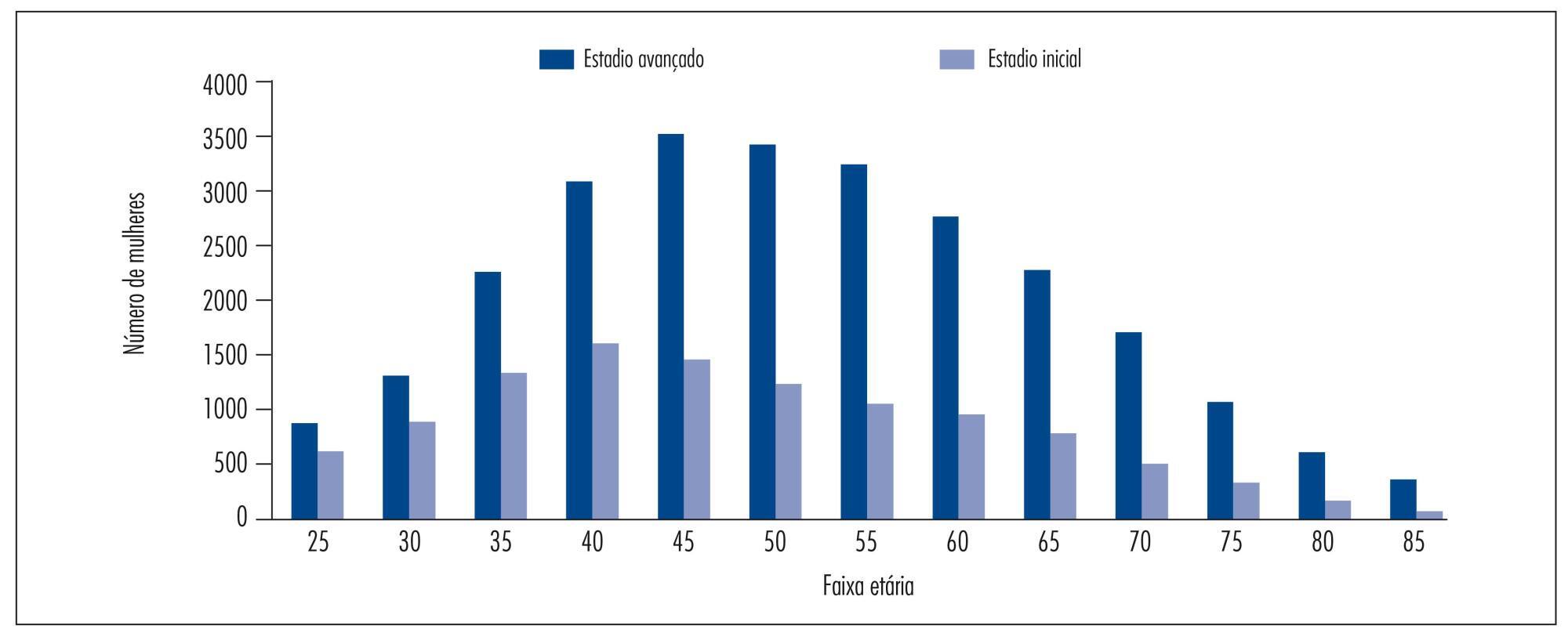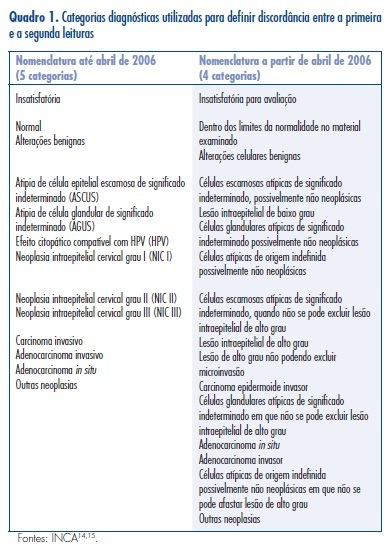You searched for:"Luiz Claudio Santos Thuler"
We found (17) results for your search.-
Original Article
Health-related Quality of Life in Women with Cervical Cancer
Rev Bras Ginecol Obstet. 2019;41(4):242-248
Summary
Original ArticleHealth-related Quality of Life in Women with Cervical Cancer
Rev Bras Ginecol Obstet. 2019;41(4):242-248
Views2See moreAbstract
Objective
To analyze the factors associated with health-related quality of life (HRQoL) in women with cervical cancer (CC) in a single center in Rio de Janeiro, state of Rio de Janeiro, Brazil.
Methods
A cross-sectional study in women with a diagnosis of CC followed-up in the gynecology outpatient clinic of the Hospital do Câncer II (HCII, in the Portuguese acronym) of the Instituto Nacional de Câncer (INCA, in the Portuguese acronym). The data were collected from March to August 2015. Women with palliative care, communication/cognition difficulty, undergoing simultaneous treatment for other types of cancer, or undergoing chemotherapy and/or radiation therapy were excluded. For the evaluation of the HRQoL, a specific questionnaire for women with CC was used (Functional Assessment of Cancer Therapy – Cervix Cancer [FACT-Cx]). The total score of the questionnaire ranges from 0 to 168, with higher scores indicating a better HRQoL.
Results
A total of 115 women were included in the present study, with a mean age of 52.64 years old (standard deviation [SD] = 12.13). The domains of emotional (16.61; SD = 4.55) and functional well-being (17.63; SD = 6.15) were those which presented the worst scores. The factors that had an association with better HRQoL in women with CC were having a current occupation, a longer time since the treatment and diagnosis, and women who had undergone hysterectomy.
Conclusion
Considering the domains of HRQoL of the women treated for cervical cancer, a better score was observed in the domains of physical and social/family wellbeing. For most domains, better scores were found between those with a current occupation, with a longer time after the diagnosis and treatment, and among those who had undergone a hysterectomy.
-
Original Article
Predictive Capability of HPV and Pap Tests in Screening for Cervical Cancer over a Three-Year Follow-up
Rev Bras Ginecol Obstet. 2016;38(3):147-153
Summary
Original ArticlePredictive Capability of HPV and Pap Tests in Screening for Cervical Cancer over a Three-Year Follow-up
Rev Bras Ginecol Obstet. 2016;38(3):147-153
Views4See morePurpose
To compare the predictive capability of HPV and Pap smear tests for screening pre-cancerous lesions of the cervix over a three-year follow-up, in a population of users of the Brazilian National Health System (SUS).
Methods
This is a retrospective cohort study of 2,032 women with satisfactory results for Pap smear and HPV tests using second-generation hybrid capture,made in a previous study. We followed them for 36 months with data obtained from medical records, the Cervix Cancer Information System (SISCOLO), and the Mortality Information System (SIM). The outcome was a histological diagnosis of cervical intraepithelial neoplasia grade 2 or more advanced lesions (CIN2ş). We constructed progression curves of the baseline test results for the period, using the Kaplan-Meier method, and estimated sensitivity, specificity, positive and negative predictive value, and positive and negative likelihood ratios for each test.
Results
A total of 1,440 women had at least one test during follow-up. Progression curves of the baseline test results indicated differences in capability to detect CIN2ş (p < 0.001) with significantly greater capability when both tests were abnormal, followed by only a positive HPV test. The HPV test was more sensitive than the Pap smear (88.7% and 73.6%, respectively; p < 0.05) and had a better negative likelihood ratio (0.13 and 0.30, respectively). Specificity and positive likelihood ratio of the tests were similar.
Conclusions
These findings corroborate the importance of HPV test as a primary cervical cancer screening.

-
Original Article
Translation and Cross-Cultural Adaptation of the Lymphoedema Functioning, Disability and Health Questionnaire for Lower Limb Lymphoedema into Portuguese Language
Rev Bras Ginecol Obstet. 2016;38(2):88-96
Summary
Original ArticleTranslation and Cross-Cultural Adaptation of the Lymphoedema Functioning, Disability and Health Questionnaire for Lower Limb Lymphoedema into Portuguese Language
Rev Bras Ginecol Obstet. 2016;38(2):88-96
Views1See moreObjective
The objective of the study is to describe the process of translation and cross-cultural adaptation of the Lymphoedema Functioning, Disability, and Health Questionnaire for Lower Limb Lymphoedema (Lymph-ICF-LL) into (Brazilian) Portuguese.
Methods
The process was comprised of five steps – translation, back translation, revision by an expert panel, pretest, and final translation. The first translation was performed by two professionals of the healthcare area, and the back translation was performed by two translators. An expert panel assessed the questions for semantics and idiomatic, cultural, and conceptual equivalence. The pretest was conducted on 10 patients with lymphedema.
Results
Small differences were identified between the translated and back-translated versions, which were revised by the expert panel. The patients included in the pretest found 10 questions difficult to understand; these questions were reassessed by the same expert panel.
Conclusion
The results of the translation and cross-cultural adaptation of the Lymph- ICF-LL resulted in a Brazilian Portuguese version, which still requires validation with various samples of the local population.

-
Original Article
Frequency and associated factors of phantom breast syndrome in women submitted to mastectomy for breast cancer
Rev Bras Ginecol Obstet. 2015;37(9):397-401
Summary
Original ArticleFrequency and associated factors of phantom breast syndrome in women submitted to mastectomy for breast cancer
Rev Bras Ginecol Obstet. 2015;37(9):397-401
DOI 10.1590/SO100-720320150005353
Views1PURPOSE:
To evaluate the frequency and risk factors for the development of phantom breast syndrome in patients submitted to mastectomy after breast cancer treatment.
METHODS:
A cohort study of women undergoing treatment at the Hospital of Cancer III, National Cancer Institute José Alencar Gomes da Silva (INCA) from September 2008 to June 2009. PBS was considered based on report of phantom breast sensation and/or phantom breast pain. The study was approved by the Research Ethics Committee of the INCA (015/08). Descriptive analysis using absolute and relative frequency was performed. To evaluate the association between PBS and potential risk factors, univariate analysis was performed by means of odds ratios (OR) with respective 95% confidence intervals (95%CI).
RESULTS:
A total of 88 patients were included. The frequency of PBS observed was 44.3 at 45 days (first follow-up) and 18.2% at 2 years (last follow-up). Most women reported phantom breast syndrome in all segments (37.1; 30.1 and 22%). During the six month follow-up, women under the age of 60 years had a 3.93 times higher risk of PBS (OR=3.9; 95%CI 1.4-10.5) and those with higher education (8 years or more of study) had a higher risk of developing PBS (OR=2.6; 95%CI 1.01-6.8).
CONCLUSION:
The study population had a high frequency of PBS, which decreased over postoperative follow-up. Its occurrence after six months was higher among younger and more educated women.
Key-words Breast neoplasm/surgeryBreast neoplasms/psychologyMastectomy/psychologyPerceptual disorders/psychologySee more -
Original Article
Determinants of late stage diagnosis of cervical cancer in Brazil
Rev Bras Ginecol Obstet. 2014;36(6):237-243
Summary
Original ArticleDeterminants of late stage diagnosis of cervical cancer in Brazil
Rev Bras Ginecol Obstet. 2014;36(6):237-243
DOI 10.1590/S0100-720320140005010
Views2See morePURPOSE:
To assess the determinants of late stage in women with cervical cancer in Brazil.
METHODS:
A cross-sectional study of secondary basis. Women with invasive cervical cancer enrolled in the Cancer Hospital Registry between January 2000 and December 2009 were included. Late clinical stage (≥IIB) was the outcome considered. The following variables were studied: age at diagnosis, race or ethnicity, years of education, marital status, alcohol consumption, smoking status, place of residence, year of diagnosis, initial treatment received, and status after the first treatment. Odds ratio (OR) with 95% confidence intervals (95%CI) and a logistic regression model were used. P values<0.05 were considered statistically significant.
Results:
37,638 cases were included, with a mean age of 52.4±14.1 years. Late clinical stages were observed in 70.6% of cases and were associated with the presence of squamous cell carcinoma (OR=1.8; 95%CI 1.7-2.0), age ≥50 years (OR=1.5; 95%CI 1.4-1.6), living with a partner (OR=1.3; 95%CI 1.2-1.4), black skin color (OR=1.2; 95%CI 1.1-1.4), and low educational level (OR=1.2; 95%CI 1.1-1.3).
CONCLUSION:
In Brazil, the diagnosis of cervical cancer is a delayed event. Although the main factor associated with late stage of cervical cancer identified in this study is a biological factors (histological type) and, consequently, not eligible for intervention, it was confirmed that socioeconomic disparities in the country are associated with late stage disease.

-
Original Article
Adherence to cervical cancer screening among woman from communities assisted by the Family Health Strategy at the Baixada Fluminense, Rio de Janeiro State, Brazil
Rev Bras Ginecol Obstet. 2014;36(5):198-204
Summary
Original ArticleAdherence to cervical cancer screening among woman from communities assisted by the Family Health Strategy at the Baixada Fluminense, Rio de Janeiro State, Brazil
Rev Bras Ginecol Obstet. 2014;36(5):198-204
DOI 10.1590/S0100-7203201400050003
Views4PURPOSE:
To assess the adherence to a cervical cancer screening program and to identify reported reasons for inadequate screening in women receiving care as part of the Family Health Strategy.
METHODS:
A selective prevalence study on cervical cancer screening in women receiving care as part of the Family Health Strategy in the cities of Duque de Caxias and Nova Iguaçu in the state of Rio de Janeiro, southeastern Brazil, nine years after they participated in a previous study of the Brazilian National Cancer Institute. Only those women who were not diagnosed with CIN II or more severe lesions by histopathology, did not undergo hysterectomy during the study period and still resided in the communities were eligible to participate in the study. Information on exam sites, test results and schedules, sociodemographic characteristics and reported reasons of non-adherence was obtained. Data were collected through interviews and medical record review. The prevalence of adherence to screening was estimated, and the chi-square test was used to compare proportions between the variables studied and their relationship with the reported reasons of non-adherence to screening.
RESULTS:
A total of 764 women were interviewed, 70.7% of whom received adequate cervical cancer screening. The reported reasons for inadequate screening included: no risk perception (44.6%), social barriers (26.3%), perceived barriers to action (22.3%) and institutional barriers (21.4%). These reasons were proportionately higher among residents of Nova Iguaçu than among residents of Duque de Caxias (p<0.01), except for institutional barriers (p=0.19).
CONCLUSIONS:
Although difficulties and barriers were reported, there was good adherence to cervical cancer screening among the women studied. Health providers should receive proper training for complying with the Brazilian Ministry of Health guidelines of regular testing and to facilitate access to screening.
Key-words Family health Women's healthmass screeningUterine cervical neoplasms/ prevention & controlSee more -
Original Article
External quality control for cervical cytology exams performed in the Brazilian Public Health System of Mato Grosso do Sul State
Rev Bras Ginecol Obstet. 2012;34(8):351-356
Summary
Original ArticleExternal quality control for cervical cytology exams performed in the Brazilian Public Health System of Mato Grosso do Sul State
Rev Bras Ginecol Obstet. 2012;34(8):351-356
DOI 10.1590/S0100-72032012000800002
Views4See morePURPOSE: To evaluate the diagnostic agreement between the cytopathology reports issued by accredited laboratories and those obtained by quality control. METHODS: We calculated the overall agreement and Cohen’s kappa coefficients of a convenience sample of smears selected monthly by the Information System of Cervical Cancer (SISCOLO) for External Quality Control of the 15 laboratories that performed cytopathological PAP tests for the Brazilian Public Health System (SUS) between 2002 and 2011 in Mato Grosso do Sul, a State of the Midwest Region of the country. A comparison of the reliability values (coefficient of concordance and Kappa coefficient) between the initial and final years was computed by the absolute change (delta) and relative percent difference (RPD). RESULTS: There were 15.989 smears sent for rereading, 48.1% of which had a report of normal/benign changes, followed by atypical/low-grade squamous intraepithelial lesions (36.3%), high grade squamous intraepithelial lesion/carcinoma/adenocarcinoma (4.2%), and unsatisfactory (11.4%). The overall correlation coefficient ranged between 0.2 and 1.0, and the median value increased from 0.7 in 2002 to 1 in 2011 (RPD=+36.6%). During the same period, the median values of the Kappa coefficient increased from 0.5 to 0.9 (RPD=+80.8%). CONCLUSIONS: These results emphasize the feasibility of the External Quality Control of cytopathology at the state level and its implementation results in improvement in the diagnoses performed in the SUS network.

-
Original Article
Evaluation of a strategy adopted to expand adherence to breast cancer screening in Brazilian Northeast
Rev Bras Ginecol Obstet. 2012;34(2):86-91
Summary
Original ArticleEvaluation of a strategy adopted to expand adherence to breast cancer screening in Brazilian Northeast
Rev Bras Ginecol Obstet. 2012;34(2):86-91
DOI 10.1590/S0100-72032012000200008
Views1PURPOSE: To evaluate the actions of the “Um Beijo Pela Vida” Program developed in a Brazilian Northeast city to increase adherence to breast cancer screening by women registered by the Brazilian Family Health Strategy for breast cancer screening. METHODS: A quantitative approach was used to evaluate the coverage of screening actions for aged 40 years-old or more. Community workers from the nine Family Health Teams of the town carried out an active search. The percentage of eligible women who were screened for breast cancer by clinical breast examination or mammography, mammogram classification according to BI-RADS®, women screened who were referred for further testing and treatment, and the number of breast cancers detected were collected by means of a structured questionnaire, analyzed with the EPI-INFO TM software and compared to previously defined patterns. RESULTS: 3,608 women were included, corresponding to 68.4% of the target population registered in the Brazilian Family Health Strategy. Coverage rates of clinical breast examination for women aged 40 to 49 years-old and of mammograms for women aged 50 to 69 years-old were 58.9 and 56.7%, respectively. All women with highly suspicious mammographic lesions were submitted to fine needle aspiration or core biopsy (100%). Six new cases of cancer were detected and 80% of the standards established for this evaluation were carried out. CONCLUSIONS: The evaluation of the actions of the Program suggests its adequacy considering the degree of fulfillment of the previously defined requirements.
Key-words breast neoplasmsGuideline adherenceHealth evaluationHealth services coveragemass screeningSee more
Search
Search in:
Tag Cloud
breast (42) breast cancer (42) breast neoplasms (95) Cesarean section (72) endometriosis (66) infertility (56) Maternal mortality (43) menopause (82) obesity (58) postpartum period (40) pregnancy (225) Pregnancy complications (99) Prenatal care (68) prenatal diagnosis (50) Prevalence (41) Quality of life (51) risk factors (94) ultrasonography (79) urinary incontinence (40) women's health (48)


